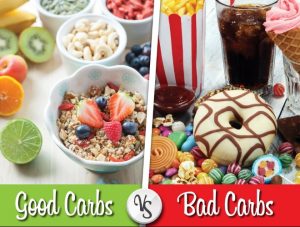No matter what you may think from watching a commercial about the latest fad diet, carbs are an essential part of your diet. But they can also be very bad for you, depending on the amount you eat and the type. A successful weight loss program minimizes bad carbs and maximizes good carbs.
What’s the Difference?
It’s easy to tell the difference between good carbs and bad carbs. Good carbs are more whole foods, including vegetables and fruits, whole grains, and legumes. Bad carbs are refined carbs that have been separated, leaving more sugars and simple carbs. If you’re looking at a part of a plant pretty much as nature made it, that’s a relatively good carb. If you’re looking at something that’s been processed in some way, either having something removed or added, that’s a relatively bad carb. Understanding the difference between good and bad carbs can make a big difference in long term weight loss.
Benefits of Good Carbs
Good carbs are more likely to come along with lots of nutrients your body needs, including vitamins and minerals. Good carbs also contain essential energy that your body can use, in the form of calories, but the form of the calories matters. In good carbs, there are a lot of complex carbohydrates, larger molecules that take time to break down. Your body will digest the simple carbs first, giving you some energy right away, and as it digests the rest of the energy slowly, you receive a steady supply to keep your body functioning at an optimal level.
But one of the most important things good carbs supply is what your body can’t digest: fiber. Fiber helps your body move food and waste through your system, and can even help absorb and remove toxins from the body. This is why high-fiber diets are good for your heart and can even diminish the risk of colon cancer. Not only that, but fiber helps you feel full so you eat less. Carbs aren’t all bad and it’s important to understand which ones can help you the most in weight loss.
Problems with Bad Carbs
But what’s wrong with a little sugar? you may ask. There’s nothing wrong with a little sugar, but Americans tend to get a lot of it. The average adult eats about 22 teaspoons of added sugar each day. That’s right, we eat 22 teaspoons of sugar that’s just for sweetening our food each and every day, on top of any sugar that may be naturally in food. That’s even more striking when you realize that the World Health Organization just revised its recommendations, saying that a healthy diet should probably include about six teaspoons of added sugar a day.
The problem is that all this sugar is ready energy. It goes immediately to your blood, causing your blood sugar level to spike, and it means that your energy level will crash as quickly as it rose. Unless you’re constantly supplying and constantly consuming a steady supply of sugars (as in running a marathon), your body will store energy as fat when it spikes, then tell you you should eat when your energy crashes.
Sorting out good and bad carbs are just one vital step in assembling a healthy diet. If you want help navigating all the important aspects of your diet, please contact Med-Fit Medical Weight Loss Clinic, where we can help you use science to achieve, rapid, healthy weight loss—and keep the weight off.

